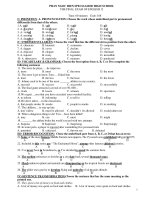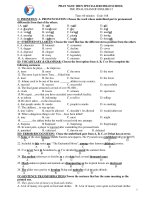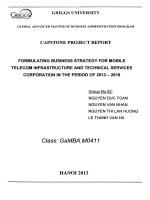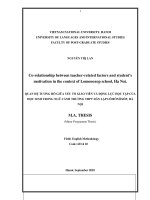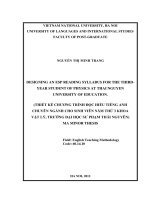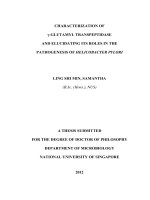Solutions, keys and scores for questions in final exam of principles of Physics 2 - ĐH Sư phạm Kỹ thuật
Bạn đang xem bản rút gọn của tài liệu. Xem và tải ngay bản đầy đủ của tài liệu tại đây (190.77 KB, 3 trang )
SOLUTIONS, KEYS AND SCORES
For Questions in Final Exam of Principles of Physics 2
Edited by: Phan Gia Anh Vu
Date of Exam: July 24th 2020
Answer
Question
1
A. It is horizontal, northward.
2
Score
0.5
In electric field, a charge of q will be exerted by the force F qE .
In this case, q is negative, so F is parallel but in opposite direction with E .
0.5
C. A = D
In the conducting spherical shell, the inner and the outer surface will possess
negative and positive charge, respectively.
q
Applying the Gauss’s law ( in ) for the Gaussian spheres that contain the
0
3
points A, B, C and D, it can be found that: A B B 0; C 0 .
D. 45.0 N/C
E
Applying the relationship between E and B: c .
B
0.5
E B c 1.50 107 3.00 108 45.0 N/C
4
0.5
B. 0.100 mm
The positions of minima are given by y L tan .
The angles in which the minima occur can be found from: d sin m With
small angles tan sin
The position of the first dark fringe is: y L
d
.
0.5 106
1 10 4 m 0.100 mm
y
5 103
The magnetic field create by the current in the wire
I
is given by B 0 . At the position of the loop,
2a
the magnetic field is perpendicular to and out of
B
the page (as in the figure on the right). The farer a
point from the wire is, the weaker the magnetic
field is.
a) If the loop moves away from the wire, the
magnetic flux through the loop will decrease. So the induced current in the
loop is counterclockwise.
b) If the loop moves to the wire, the magnetic flux through the loop will
increase. So the induced current in the loop is clockwise.
So d L
5
1
Page 3
0.5
0.5
6
7
Applying the right hand rule, we can find the
direction of the magnetic field created by the
current I1 at the position of I2 as in the figure.
The force exerting on the wire carrying I2 is
vertical and upwards.
As the result, the two wires attract each other.
0.5
0.5
×
Let number the charges from 1 to 4 as in the figure. The electric fields created by the
2
charges q1, q2, q3, q4 are E1 , E2 , E3 , E4 , respectively.
3
0,5
We can see that E2 E4 ; E1 2 E3 .
So the total electric field at the square center is:
E E1 E2 E3 E4 3E3 .
The magnitude of E3 is:
E3
9 10 6 10 4.32 10
9
kq
a 2
2
2
0,5
12
6
2
7
4
Nm 2 /C .
0.05 2
2
8
2
2
So the magnitude of E is: E 3E3 1.30 10 Nm /C .
7
2
2
Or: E 9.19 10 iˆ ˆj N.m /C
0,5
b) If a fifth charge is located at O, it will be exerted by the force:
F qE 6.00 10 6 9.19 10 7 iˆ ˆj 551 iˆ ˆj N (the red arrow 0,5
in the above figure).
The magnitude of this force is: F 780 N .
8
a) The current I1 creates a magnetic field B1 that is
perpendicular to the page and directs into the page.
In order to have the zero total magnetic field at O,
the current I2 must create the magnetic field B2 so
O
that: B2 B1
0,5
Thus, the current I2 has to be in opposite direction
of the current I1 and have the magnitude that:
I
I
I
2 0 or 2 1 .
2 r1 r2
r2 r1
r2
9
5 3.75 A .
Thus: I 2 I1
r1
12
B
0 I1
0,5
So I2 is counterclockwise and has the magnitude of: 3.75 A.
b) If the direction of I2 remains unchanged but its magnitude is doubled, then the
0,5
total magnetic field at O is nonzero. Now, B1 B2 , so the total field has the
same direction with B2 (out of the page). The magnitude of B is:
I2
9
I 4 10 7
2
2 r1 r2
2
0 I1
5
2 3.75
5
2.62 10 T
0.09
0.12
0,5
a) From the condition of constructively reflection on the thin film:
2 nt
2
2
0,5
m
Page 4
It can be found that:
2 nt
.
m
The first three longest wavelengths are corresponding with the three smallest
value of m : 1, 2 and 3.
2 1.38 5.00 10 7
1.38 10 4 m 1.38 μm
1
2 1.38 5.00 10 7
2
0.690 μm
2
2 1.38 5.00 10 7
3
0.460 μm
3
1
b) From these wavelengths, there are 2 wavelengths in the visible spectrum.
0.690 μm; 0.460 μm
Page 5
0,5
0,5
0,5

